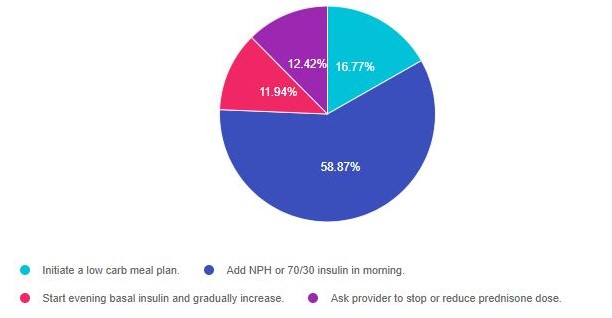
For our March 2nd Question of the Week, over 58% of respondents chose the best answer!
Before we start though, if you don’t want any spoilers and haven’t tried the question yet, you can answer below: Answer Question
Question: JR is 53 yrs old with type 2 diabetes, BMI of 24.3 and is recovering from a COVID infection. In addition to metformin, a SGLT-2i and a weekly GLP-1 RA, JR is on daily prednisone. Morning blood glucose levels are in the low 100’s, lunch and dinner blood glucose levels are in the 250-300 range.
Which of the following is the best treatment intervention to get lunch and dinner blood glucose levels to goal?
Answer Choices:
- Initiate a low carb meal plan
- Add NPH or 70/30 insulin in morning
- Start evening basal insulin and gradually increase
- Ask provider to stop or reduce prednisone dose

As shown above, the most common choice was option 2, the second most common answer was option 1, then option 4, and finally option 3.
Getting to the Best Answer
If you are thinking about taking the certification exam, the content of this practice test question will set you up for success. The exam often presents vignettes that compel test takers to determine which option offers the BEST answer based on the action times of different insulins.
Answers & Rationale
Answer 1 is incorrect, 16.77% chose this answer. “Initiate a low carb meal plan “. JR has a BMI that is less than 25, which indicates a healthy weight. In addition, JR is recovering from COVID, so making sure they are eating adequate calories and healthy carbs during this recovery phase is very important. Lastly, the spike in blood glucose between lunch and dinner is an expected response since JR is taking morning prednisone.
AM steroids cause hyperglycemia through lunch and dinner.
Answer 2 is correct, 58.87% of you chose this answer. “Add NPH or 70/30 insulin in morning”. YES! Since morning steroids increase insulin resistance throughout the day, especially around lunch and dinner time, morning NPH insulin works remarkably well. This is because NPH action time peaks within 4-10 hours of injection. Another option is to use 70/30 insulin, which is a combination of 70% NPH (or basal) insulin plus 30% bolus. This insulin used before the first meal of the day, can help prevent lunch and dinner blood sugars from going above target later in the day.
Dosing for NPH or 70/30 depends on several factors, including steroid dose, diabetes type and history, body weight and health status. See our article on Steroids and Sugar Spikes – Management Strategies
Answer 3 is incorrect, 11.94% of you chose this answer “Start evening basal insulin and gradually increase”. When people are on morning steroids, their overnight blood sugars generally trend down. Basal insulin isn’t the best choice for addressing mid day to evening glucose elevations.
Answer 4 is incorrect, 12.42% of you chose this answer. “Ask provider to stop or reduce prednisone dose”. While it is true that stopping the prednisone will improve blood glucose levels, it could also contribute to a worsening health status. One of the most effective treatments for people with a serious COVID infection is steroid therapy to decrease inflammation, especially in the lungs. We approach this situation understanding that the steroid is essential and we can help with glucose management to promote recovery.
Want to learn more about this topic? Join Coach Beverly during the Virtual Conference, where she will be discussing treatment strategies for hyperglycemia secondary to steroids.
We hope you appreciate this week’s rationale! Thank you so much for taking the time to answer our Question of the Week and participate in this fun learning activity!
ADCES Desk Reference + 5th Ed Review Guide Book Bundle
The 5th Edition ADCES Desk Reference & 5th Edition Review Guide Bundle –our most popular AADE Book Bundle for exam preparation!
What is included in the ADCES Book Bundle?
The Art & Science of Diabetes Self-Management Education Desk Reference – 5th Edition
Major Features:
- practical information educators can use with patients to avoid complications and comorbidities
- risks and benefits of CGM and the educator’s role in working with patients who use CGM
- updated info on incorporating the ADA, AADE, and AND joint position statement and algorithm of care into a DSME program
ADECES Review Guide for the Diabetes Care and Education Specialist Exam – 5th Edition
Includes an answer key with rationales for all questions included in the guide!
Major Features:
- 480 + multiple-choice questions
- Strategies for preparing for and taking the exam
3 self-assessment tests that cover three main content sections on the CDCES Exam:
- Assessment of Diabetes and Prediabetes
- Interventions for Diabetes and Prediabetes
- Disease Management
Sign up for Diabetes Blog Bytes – we post one daily Blog Byte from Monday to Friday. And of course, Tuesday is our Question of the Week. It’s Informative and FREE! Sign up below!
[yikes-mailchimp form=”1″]
Accreditation: Diabetes Education Services is an approved provider by the California Board of Registered Nursing, Provider 12640, and Commission on Dietetic Registration (CDR), Provider DI002. Since these programs are approved by the CDR it satisfies the CE requirements for the CDCES regardless of your profession.*
The use of DES products does not guarantee the successful passage of the CDCES exam. CBDCE does not endorse any preparatory or review materials for the CDCES exam, except for those published by CBDCE.









